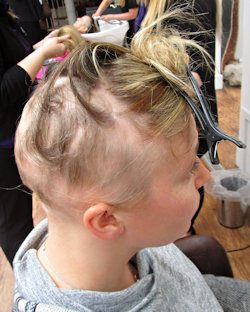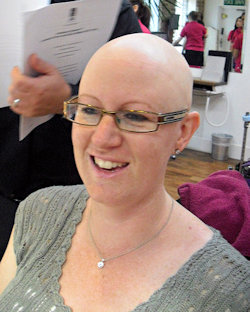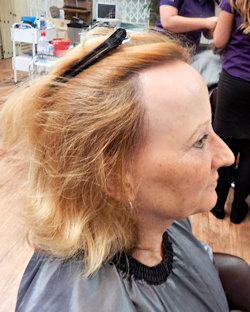The problems of hair loss due to alopecia were highlighted last year by an unfortunate joke told at the Oscar ceremonies. That triggered actor Will Smith to slap the comedian who told it – Smith felt it was pointed at his wife, Jada Pinkett Smith, who suffers from the condition. The video of this was soon being shown all round the world and produced considerable discussion on social media.
There are a number of different types of alopecia and this article explains what they are and the differences between them.
Alopecia areata
 This is one of the most commonly reported types of hair loss, referring to bald patches or spots on the scalp.(areata simply mean patchy)
This is one of the most commonly reported types of hair loss, referring to bald patches or spots on the scalp.(areata simply mean patchy)
It is considered to be an auto-immune disorder and can appear at any age, although there seems to be a bias towards younger people. Stress and emotional trauma, such as a bereavement, are commonly reported as triggers.
There seems to be some tendancy towards a genetic connection – if one of your parents had it there’s a slightly greater chance that you may get it – but it’s not considered a major factor.
The progress of AA can be very unpredictable – sometimes the hair grows back and the problem goes away, but it can just as easily recur without warning or fresh patches appear in different places. Some people can suffer a recurring cycle of loss and regrowth for many years. Medical treatments are similarly unpredictable – what works for one person may not work for another.
Read more information and examples of our approach to disguising it.
Alopecia totalis
 This version of alopecia affects the whole of the head, often including eyelashes and eyebrows.
This version of alopecia affects the whole of the head, often including eyelashes and eyebrows.
It’s a more advanced stage of alopecia areata, which progresses to totalis and universalis in around 1 – 2 per cent of cases.
Alopecia universalis
This term relates to hair loss all over the body, meaning that the entire epidermis is free from hair. It is the most severe form of alopecia areata, and is therefore quite rare, occurring only in around 1 in 100,000 people. It came to public attention in the 1980s when Olympic swimming gold medallist Duncan Goodhew revealed he suffered from it.
Androgenetic Alopecia
Commonly know as Pattern Hair Loss there are male and female versions which are different in appearance. The male pattern normally recedes from the front or the temples, leaving a bald area in its wake, whereas the female patttern is much more diffuse – showing as thinnning over the head in general. More information on Female Pattern Hair Loss.
Frontal Fibrosing Alopecia
 Also known as Scarring Alopecia or Cicatricial Alopecia, it was only identified as recently as 1994 but seems to be becoming more common.
Also known as Scarring Alopecia or Cicatricial Alopecia, it was only identified as recently as 1994 but seems to be becoming more common.
As with the related condition Lichen Planopilaris, this type of hair loss is permanent due to the scar tissue generated by the inflammation that causes it. The hair follicles are destroyed and cannot grow back.
It is characterised by a receding of the hairline at the front and sides of the scalp. More information on FFA.
Traction Alopecia
This is where hair falls out due to physical stress on the follicles – usually caused by overly-tight hair styles such as severe ponytails, tight buns or cornrows, or by badly-fitted and/or too heavy extensions or weaves. If the cause is discontinued the hair may return to normal but if it has been going on for too long their may be permanent damage.
There are No Cures…
While there are various creams and medicines which can help some of these conditions in some cases, for instance corticosteroid immunosuppressants are sometimes prescribed for the autoimmune types, there are no definite cures, and some of the treatments have side-effects or are only suitable for men. Such treatments should only be used under medical advice and we do not offer them. However we do recommend that medical advice is sought at the onset of sudden hair loss in case it is an indicator of another disease or condition.
…but there are ways to look good

We can disguise female hair loss very effectively with a variety of hair systems which we have developed and pioneered over the last four decades. These include the Intralace System options and ultra-fine hair extensions called Medi Connections.
If you’d like to explore those options then come and talk to us and we can asses the best approach for you. In the UK we have six studios across the country, with a new studio in Newcastle due to open in summer 2023.
Contact details and/or enquiry forms are on the following pages:
